The learning environment is what will help create community. Before anything, students need to feel safe. Not just physically safe, but safe to learn how they learn, safe to think “outside the box”, safe to ask questions, safe to make mistakes, safe to be who they are. I recently read a post by Jackie Gerstein, a friend and mentor who talks passionately about the importance of community in the classroom (It’s About Connections Not Content). Below, I talk about the learning spaces to honour all learners. It is my intention to help these students find their passions, their gifts, and their understanding of themselves.
The Circle
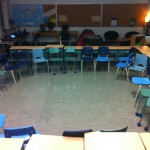 Each day, we start off in a large circle. We might play a game, talk about a current event or gather our ideas for upcoming lessons. The circle gives brings the class together as one team, a group of co-learners and a support structure that they will need.
Each day, we start off in a large circle. We might play a game, talk about a current event or gather our ideas for upcoming lessons. The circle gives brings the class together as one team, a group of co-learners and a support structure that they will need.
Comfort and Escape
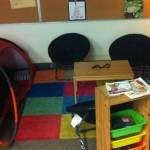 A few years ago, I taught in a brand new school with small classrooms. A quiet “comfy” space was not an option and was strictly forbidden by fire regulations. I yearned to provide my students with an area to go when they needed to unpack and reflect. As we know, this 7 hour day, surrounded by an assortment of individuals can be overwhelming and draining. This classroom (an older school) allows for this space. Students can use it to work collaboratively using the bulletin board or small table or even the floor as a workspace. Of course, reading a book, plugged into a good song is also pretty fantastic for any learner.
A few years ago, I taught in a brand new school with small classrooms. A quiet “comfy” space was not an option and was strictly forbidden by fire regulations. I yearned to provide my students with an area to go when they needed to unpack and reflect. As we know, this 7 hour day, surrounded by an assortment of individuals can be overwhelming and draining. This classroom (an older school) allows for this space. Students can use it to work collaboratively using the bulletin board or small table or even the floor as a workspace. Of course, reading a book, plugged into a good song is also pretty fantastic for any learner.
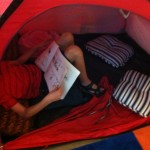 It only took about one hour before a student crawled into this “getaway”. A calming environment that is still in the same room is a true gift for any classroom.
It only took about one hour before a student crawled into this “getaway”. A calming environment that is still in the same room is a true gift for any classroom.
Exercise – Meditative, focus~refocus, transition
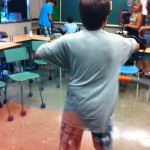 I truly love to Hula-Hoop. Not only because it is great for the abdominal muscles, but the repetitive motion is soothing. After a long day, or a long think-session, there is nothing better then grabbing a hula-hoop, with a little music (or quiet is good too) and finding a place to gather thoughts and re-fuel for the next “thing” to come. Another true gift that this classroom offers – enough space.
I truly love to Hula-Hoop. Not only because it is great for the abdominal muscles, but the repetitive motion is soothing. After a long day, or a long think-session, there is nothing better then grabbing a hula-hoop, with a little music (or quiet is good too) and finding a place to gather thoughts and re-fuel for the next “thing” to come. Another true gift that this classroom offers – enough space.
Game
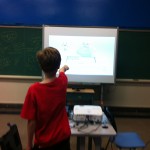 There has been much debate about the use of Gaming in the classroom and its integration into core subjects like math, social studies and language. The Kinect offers an incredibly fun way for students to work together in solving problems, debating stories and characters, and thinking through puzzles and math games. Allowing students to move around, challenge one another and discuss the creation and process of the game itself is incredible insightful and meets them in their world. We will be integrating Minecraft in our classroom this year, as a way to plan, think, and discuss through creation and collaborative building.
There has been much debate about the use of Gaming in the classroom and its integration into core subjects like math, social studies and language. The Kinect offers an incredibly fun way for students to work together in solving problems, debating stories and characters, and thinking through puzzles and math games. Allowing students to move around, challenge one another and discuss the creation and process of the game itself is incredible insightful and meets them in their world. We will be integrating Minecraft in our classroom this year, as a way to plan, think, and discuss through creation and collaborative building.
Apple TV, Reflection, Interaction.
So often, we use the projector and whiteboard to deliver instruction and content. But with the Reflection App or Apple TV, students can broadcast their work and designs on a larger surface. To show the students a quick video, or demonstrate an iPad tool, I can stand anywhere in the room and broadcast quickly and safely. Even better, students can broadcast their work. Only a few years ago, I found myself stumbling trying to improve my motor skills when using the Smart tablet.
Group Think-Tank and iPad Center
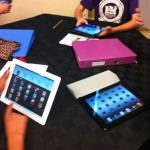 One of my students asked, “Too bad we can’t just write on this table!”. I wonder if “Idea Paint” would work here. To move away from their desk workspace to a group workspace is valuable. It is also valuable to have an option to go back to ones own individual space. With the use of the HWDSB iPad program and the School iPad purchases, I have about 10 iPads in the classroom. We will start of with interview videos. A favourite app used today was WORLD OF SAND. I highly recommend it. Highly.
One of my students asked, “Too bad we can’t just write on this table!”. I wonder if “Idea Paint” would work here. To move away from their desk workspace to a group workspace is valuable. It is also valuable to have an option to go back to ones own individual space. With the use of the HWDSB iPad program and the School iPad purchases, I have about 10 iPads in the classroom. We will start of with interview videos. A favourite app used today was WORLD OF SAND. I highly recommend it. Highly.
Weekly Schedule, Handouts and TEA.
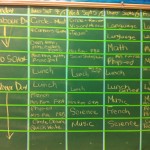 Posting a daily overview is important, but to see it in context within the entire week is essential. Like adults learners, our younger students want to know what is next and why, and especially how it relates to their learning. There is a definite accountability attached to this practice, but it is so worth it. At the end of the week, I brew tea and together we work on the next weekly schedule. It empowers them and gives them voice.
Posting a daily overview is important, but to see it in context within the entire week is essential. Like adults learners, our younger students want to know what is next and why, and especially how it relates to their learning. There is a definite accountability attached to this practice, but it is so worth it. At the end of the week, I brew tea and together we work on the next weekly schedule. It empowers them and gives them voice.
Choices and Voices
 This image keeps changing. As students become more comfortable with me – and more confident, they start adding more ideas and information here. It is fascinating to see how many students ask to get away from the brick and mortar. They want field trips, walks, and to learn outside.
This image keeps changing. As students become more comfortable with me – and more confident, they start adding more ideas and information here. It is fascinating to see how many students ask to get away from the brick and mortar. They want field trips, walks, and to learn outside.
Online
Blended learning is not only going to provide more solid communication and on-going information for students and parents, but also more access to content and learning. While it might be surprising to some (ha, ha!), I am not the bearer of all knowledge and information. Neither is the Internet. A blended learning platform (where students can also learn online) such as EDMODO (something new I’m trying this year) will allow me to facilitate content that is rich and diverse to a group of students that vary greatly in learning needs. As well, each student will be given a personal blog, and will have access to my daily plans through Google Docs and our classroom blog (another huge accountability risk that is worth the immense outcome).
Community
 My favourite learning space – The real world. This year, I’ve established a partnership with the Hamilton Farmers Market where students will get a chance to learn stories of the lives of real Hamiltonians. Students will learn to shop, cook and share resources. Most importantly, they will have an opportunity to socialize and interact with citizens and with each other in authentic ways. With some structure and guidance, they will have a chance to apply what they have learned at school to something real.
My favourite learning space – The real world. This year, I’ve established a partnership with the Hamilton Farmers Market where students will get a chance to learn stories of the lives of real Hamiltonians. Students will learn to shop, cook and share resources. Most importantly, they will have an opportunity to socialize and interact with citizens and with each other in authentic ways. With some structure and guidance, they will have a chance to apply what they have learned at school to something real.
We have also arrange for several community walks. Our school location is surrounded by hundreds of acres of forests (Royal Botanical Gardens) and wooded trails. The colours, smells, sounds and wildlife are the inspiration I’ll need when teaching poetry and creative writing. Perfect for finding space and time to talk, share and develop a real sense of self.


